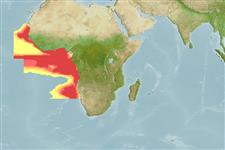>
Acropomatiformes (Oceanic basses) >
Synagropidae (Splitfin ocean-basses)
Etymology: Kaperangus: Name from the Russian 'kaperang', which is an abbreviation for the rank of captain required for long range oceanic cruises; dedicated to the crews of research vessels who have collected so many marine organisms for scientists..
More on author: Norman.
Environment: milieu / climate zone / depth range / distribution range
Ecologia
marino batipelagico; distribuzione batimetrica 50 - 500 m (Ref. 26999), usually ? - 200 m (Ref. 6916). Deep-water; 21°N - 24°S, 26°W - 15°E (Ref. 116586)
Eastern Atlantic: from Mauritania to Namibia.
Size / Peso / Age
Maturity: Lm ? range ? - ? cm
Max length : 16.5 cm SL maschio/sesso non determinato; (Ref. 6916)
Short description
Chiavi di identificazione | Morfologia | Morfometria
Spine dorsali (totale) : 10; Raggi dorsali molli (totale) : 9; Spine anali: 2; Raggi anali molli: 9. Dark brownish dorsally, paler below.
Found over mud bottom (Ref. 26999). Most abundant at about 200 m (Ref. 6916). Feeds on pelagic crustaceans like euphausiids, mysids and decapods (Ref. 27637).
Life cycle and mating behavior
Maturities | Riproduzione | Spawnings | Egg(s) | Fecundities | Larve
Smith, C.L., 1990. Moronidae. p. 692-694. In J.C. Quero, J.C. Hureau, C. Karrer, A. Post and L. Saldanha (eds.) Check-list of the fishes of the eastern tropical Atlantic (CLOFETA). JNICT, Lisbon; SEI, Paris; and UNESCO, Paris. Vol. 2. (Ref. 6916)
IUCN Red List Status (Ref. 130435)
Threat to humans
Harmless
Human uses
Strumenti
Special reports
Download XML
Fonti Internet
Estimates based on models
Preferred temperature (Ref.
123201): 12.4 - 14.2, mean 13.5 °C (based on 8 cells).
Phylogenetic diversity index (Ref.
82804): PD
50 = 1.0000 [Uniqueness, from 0.5 = low to 2.0 = high].
Bayesian length-weight: a=0.00955 (0.00424 - 0.02152), b=3.02 (2.82 - 3.22), in cm total length, based on LWR estimates for this (Sub)family-body shape (Ref.
93245).
Trophic level (Ref.
69278): 3.2 ±0.37 se; based on food items.
Resilienza (Ref.
120179): Medio, tempo minimo di raddoppiamento della popolazione 1.4 - 4.4 anni (Assuming tmax>3).
Fishing Vulnerability (Ref.
59153): Low vulnerability (10 of 100).
